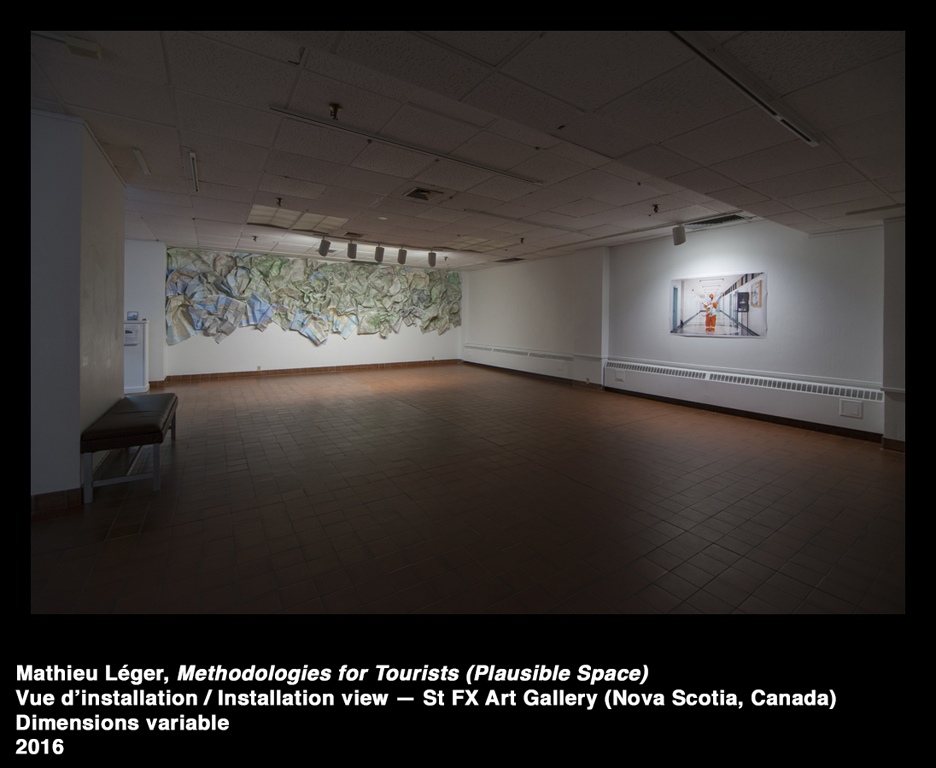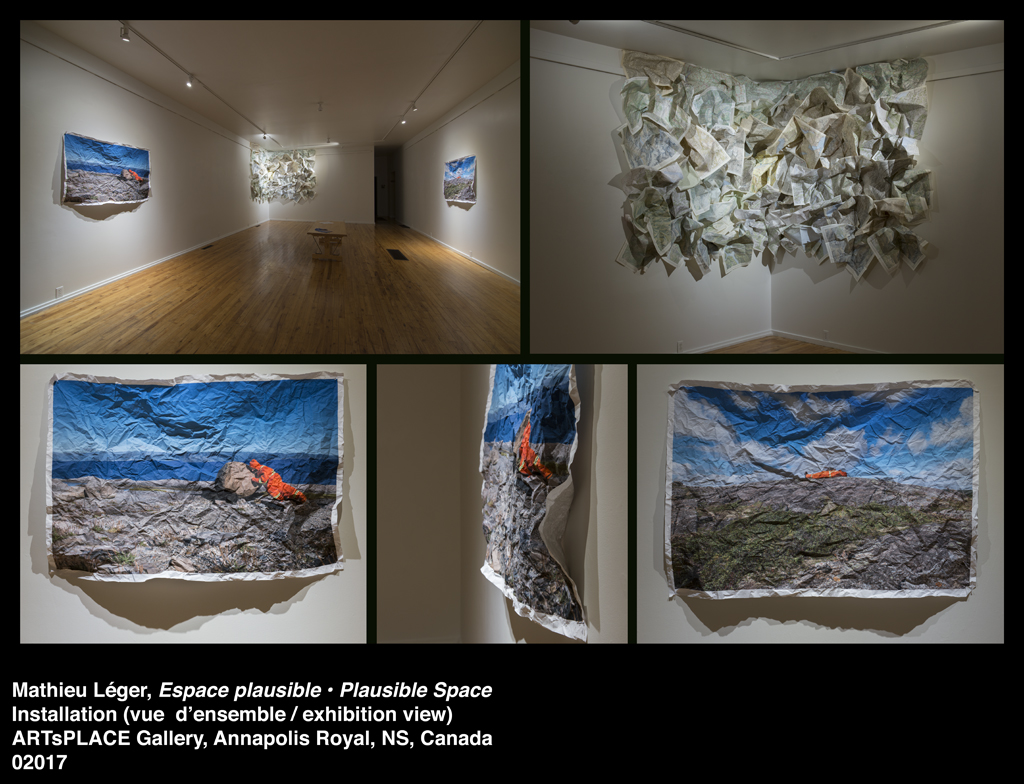Plausible Space / Espace plausible













Plausible Space
Exhibition locations: Galerie Sans Nom, Moncton, NB, Canada (02016), StFX University Art Gallery in Antigonish, NS (02016), ARTsPLACE Gallery, Annapolis Royal, NS (02017), Union Gallery, Queen’s University, Kingston, ON (02017), Langage Plus, Alma, QC (02019), Centre des arts et de la culture de Dieppe, Dieppe, NB (02019), Galerie MurMur, Moncton, NB (02019).
This project encompasses cartography, human scale, the physical side of topography, appropriation of territory, and identity. The exhibition is flexible and the proportions of the map wall can change; the two photographs are from the series Methodologies for Tourists (02013-02017). This installation is a grouping of maps from the collection of a deceased Swiss man. Purchased at a flea market in Geneva, the maps are installed to reflect what they represent; a terrestrial landscape with mountains, valleys, and seas. The two photographs included in the installation propose two situations for the performer: one where the character attempts a territorial reclamation of a place, the other a possible transformation of a territory. The images are installed as a counterpoint to the maps, initiating a dialogue between the representation of territory and our behaviour within and in relation to it.
These works explore the very nature of territorialisation. The juxtaposition of photographs acts as a landmark, a triangulation, like a GPS system. The photographs are crushed and crumpled so that they themselves become a topography; here, they become a symbol of the manipulation of the earth's body, of metamorphosis. The information in the image is then distorted, leaving an action in the landscape that is more mysterious and somewhat illegible. Within a landscape, we only have one perspective at a time. The shadows at the bottom of the photographs themselves become a horizon line, yet another metaphor for the precariousness of the landscape, where a change in light can change its form. Overall, the exhibition is almost a rendering of how these geographic systems function and how we position ourselves within them.
Espace plausible
Lieux d’exposition : Galerie Sans Nom, Moncton, NB, Canada (02016), StFX University Art Gallery in Antigonish, NS (02016), ARTsPLACE Gallery, Annapolis Royal, NS (02017), Union Gallery, Queen’s University, Kingston, ON (02017), Langage Plus, Alma, QC (02019), Centre des arts et de la culture de Dieppe, Dieppe, NB (02019), Galerie MurMur, Moncton, NB (02019).
Ce projet englobe la cartographie, l’échelle humaine, le côté physique de la topographie, l’appropriation du territoire et l’identité. L’exposition est flexible et les proportions du mur de cartes peuvent changer, les deux photographies proviennent de la série Méthodologies pour touristes (02013-02017). Cette installation est un regroupement de cartes géographiques de la collection d’un homme suisse décédé. Achetées dans un marché aux puces de Genève, les cartes sont installées pour refléter ce qu’elles représentent; un paysage terrestre avec des montagnes, des vallées et des mers. Les deux photographies incluses dans l’installation proposent deux situations de la part du performeur: une situation où le personnage tente une réclamation territoriale d’un lieu, l’autre une transformation possible d’un territoire. Les images sont installées en contrepoint des cartes pour amorcer un dialogue entre la représentation du territoire et notre comportement à l’intérieur et en rapport avec celui-ci.
Ces oeuvres explorent la nature même de la territorialisation. La juxtaposition des photographies agit comme point de repère, une triangulation, comme un système GPS. Les photographies sont écrasées et froissées pour qu’elles deviennent elles-mêmes une topographie; elles deviennent ici un symbole de la manipulation du corps terrestre, de la métamorphose. L'information contenue dans l'image est alors déformée, laissant dans le paysage une action plus mystérieuse et quelque peu lisible. Dans un paysage, nous n'avons qu'une seule perspective à la fois. Les ombrages au bas des photographies deviennent eux-mêmes une ligne d’horizon, encore une métaphore de la précarité du paysage, où un changement de lumière peut muer la forme. Dans l'ensemble, l'exposition est presque une représentation du fonctionnement de ces systèmes géographiques et de la manière dont nous nous y positionnons.
L'artiste désire remercier artsnb et le Conseil des arts du Canada pour leurs appui.
The artist would like to acknowledge the support of artsnb and the Canada Council for the Arts.